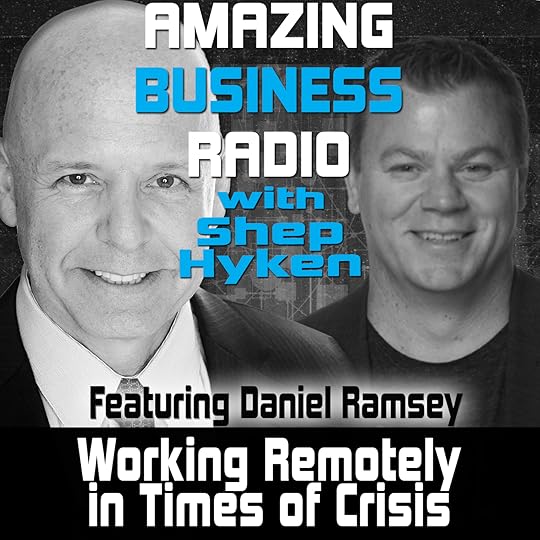Shep Hyken's Blog, page 107
April 22, 2020
There’s Magic in Managing the Details
“Detail is no detail.” I’m not sure where I heard this first. I even did a Google search and couldn’t find it. Maybe I made it up. If I did, this is what I meant by it: details are important.
They must be purposeful. Some of the “little things” that seemingly don’t matter can actually be very important.
An example of this comes right out of my recently released book, the updated and revised version of The Cult of the Customer. On page 163, I wrote, “Our perceptions of the organizations with which we choose to work are inevitably shaped by a sequence of seemingly little experiences that can go either well or poorly.” The examples include demonstrated positive experiences by focusing on the “small stuff.”
For example, when guests sit down for dinner at the Italian restaurant chain Brio, they probably don’t notice that the colored sugar packets on the table are carefully arranged with exactly 12 pink packets, 12 yellow packets and 12 white packets. Each time a guest leaves, the staff makes sure the sugar packets are replenished, if necessary.
I asked a manager about this and he gave me a great explanation. The short version is that when someone comes to work at Brio, they are taught to manage a number of these small details. This sets the tone for them to manage other details, even the ones they aren’t officially trained to manage. In other words, the employees are trained to have a “manage the details” mindset.
Consider this example of the sugar packets as a metaphor for the importance of all details. When we train our teams to pay attention to the small, seemingly unimportant details, we’re also training them to pay attention to something much larger than a detail.
When I was a teenager working at a gas station, an executive from the head office came to visit us one day. As we were walking around the station, he noticed one of our metal signs had a very slight bend in the corner. Let emphasize that it was a very slight bend. The executive pulled out a notebook and wrote down a reminder to get the signed fixed. He mentioned to me that if someone brushed up against the sign it may snag their clothing. He’d get the maintenance guy to bend it back or replace it.
I was so impressed that he spotted that small detail. From that point on, I started spotting and managing the details. It stuck with me throughout my employment at the gas station—and the rest of my life.
The point of all of this is that leaders and managers must model how we want our teams to behave. We lead, coach and teach. Help everyone understand what it’s like to have a detail-oriented mindset. By the way, anyone—regardless of their title or position in a company—can be a great role model for this one. Let me wrap this up in one simple sentence: When a manager or a leader puts detail into the operation—such as sugar packets on a table—it helps set the mindset of the other employees to focus on the details as well.
Shep Hyken is a customer service expert, keynote speaker, and New York Times bestselling business author. For information, contact 314-692-2200 or www.hyken.com. For information on The Customer Focus™ customer service training programs, go to www.thecustomerfocus.com. Follow on Twitter: @Hyken
(Copyright © MMXX, Shep Hyken)
The post There’s Magic in Managing the Details appeared first on Shep Hyken.
April 21, 2020
Amazing Business Radio: Eric Chester

Start by Being a Great Place to Work
Hiring the Right Employees to Deliver Exceptional Customer Service
Shep Hyken interviews Eric Chester. They discuss tips, tactics and strategies on hiring from his latest book, Fully Staffed: The Definitive Guide to Finding & Keeping Great Employees in the Worst Labor Market Ever.








Top Takeaways:
When the economy is bustling and the unemployment rate is low, the resultant labor shortage makes it very difficult to find (and keep) the best employees for the job.
Even a single bad employee can dramatically impact the morale of other employees. But customer service ultimately suffers the most at the hands of a bad employee.
When you understand the differences between yourself and your employees, you will understand how to manage them better and ultimately be a better boss and leader. Additionally, try to help your employees get where they want to go.
Research your present workforce—understand what makes your current great employees a good fit. Then seek out new candidates who have a similar background, traits, attitude, skillset, etc.
Expand your search for the perfect candidate to new “hunting grounds.” Become aware of nearby colleges, high schools, vocational schools, etc.—places you think are a good source for new hires.
It doesn’t matter if you have the best hiring practices if you don’t have an employee retention strategy—a way to improve your workspace.
Survey your employees regularly and ask them three questions: what they like about working there, what they don’t like about working there and what one thing they would change if they could.
Remember: it all starts with being a great place to work.
Quotes:
“It starts with being a great place to work. You have to work on that every single day.”
“Hopefully, you’re going to be a better employer tomorrow. If you’re not, you’re standing still and you’re going get run over.”
“If you ask your employees, you will get information that will totally change you and you will find out things you never knew before.”
About:
Eric Chester is an award-winning speaker and bestselling author of five books. His latest book is Fully Staffed: The Definitive Guide to Finding & Keeping Great Employees in the Worst Labor Market Ever.
Shep Hyken is a customer service and experience expert, New York Times bestselling author, award-winning keynote speaker, and your host of Amazing Business Radio.
The post Amazing Business Radio: Eric Chester appeared first on Shep Hyken.
April 20, 2020
5 Top Customer Service Articles For the Week of April 20, 2020
Each week I read a number of customer service and customer experience articles from various resources. Here are my top five picks from last week. I have added my comment about each article and would like to hear what you think too.
Loyalty programs boost businesses’ ability to keep customers by Jill Young Miller
(Washington University in St. Louis) In business, simple loyalty programs can strongly increase customer retention, Washington University in St. Louis researchers have found. And when the U.S. economy edges closer to normal following the global coronavirus pandemic, such programs may be a method to help businesses get back on their feet.
My Comment: I’ve always said that many loyalty programs are often marketing programs, where repeat purchases earn points or free merchandise. A research team at Washington University Business School came out with some interesting research about how just being part of a simple loyalty or rewards program, drives repeat business.
7 Ways to Add More Value to Your Loyalty Program by Emily Rudin
(Oracle) Let’s take a look at the ways you can build stronger, more profitable relationships with your customers and engage loyalty members beyond transactions.
My Comment: And while we’re on the subject of loyalty programs, our friends at Oracle in their Modern Marketing Blog share seven ways to add more value to a program. Even though it appears consumer-based (B2C), there is good info for any type of business. Also, pay attention to number seven, which is a strong way to create a better connection; by delivering the right content in a content marketing strategy. (My favorite company that does this is Nike.)
Surveys in the Time of Pandemic by Jim Tincher
(Heart of the Customer) I reached out to some of my CX thought-leader friends to get their perceptions of what we should be doing.
My Comment: In the midst of the COVID-19 pandemic, is it appropriate to survey our customers? The short answer is “yes,” but there is a right way and a wrong way to go about it. This article features the opinion of seven customer service and experience experts (myself included) sharing the do’s and don’ts of surveys in these unsettling times.
How to enhance customer service with a consultative approach by Andrea Grodnitzky
(Retail Customer Experience) Despite all of these factors, training your team to apply a consultative approach is a way to enhance the shopping experience for each and every customer.
My Comment: Many years ago I researched the idea of how customer service and sales belong together. The term “consultative selling” was the popular descriptor of that time. This article brings that concept back. The server at a restaurant that helps steer you into making a good choice for dinner. Or, the software sales rep who helps you choose the best solution for your business. They don’t take orders. They consult with you to get you the best. This is how you want your people to treat their customers; with a consultative approach, that enhances their customer experience.
Give Customers What They Want: 11 Tips On How To Listen Effectively by Young Entrepreneur Council
(Forbes) Today’s consumers demand transparency and honesty from brands they buy from. They expect their voices to be heard, which means attracting and retaining customers is all about listening to your audience.
My Comment: This article isn’t about personal listening techniques. It’s more about the strategy a company has to listen to its customers, and just as important, make their customers feel as if they have been heard. “Listening” is more than hearing one customer’s feedback. Here is a list of ideas that has something for every type of business.
BONUS
14 Essential Customer Experience Books to Help You Rethink Your CX by Tom Treanor
(Arm Treasure Data) To help you puzzle out the right response to rapidly changing consumer needs, we’ve compiled a list of 14 CX books to read right now.
My Comment: Looking to expand your mind while in quarantine? What a better time to do so… Grow when it’s slow. Here is a list of 14 customer experience books by a “who’s who” in this important field. I’m honored and flattered that my latest book, the updated version of “Cult of the Customer,” (LINK TO AMAZON) made the top of the list. Thank you, Tom Treanor, (@RtMixMktg) for including me!
 Shep Hyken is a customer service expert, professional speaker and New York Times bestselling business author. For information on The Customer Focus™ customer service training programs go to www.TheCustomerFocus.com. Follow on Twitter: @Hyken
Shep Hyken is a customer service expert, professional speaker and New York Times bestselling business author. For information on The Customer Focus™ customer service training programs go to www.TheCustomerFocus.com. Follow on Twitter: @Hyken
The post 5 Top Customer Service Articles For the Week of April 20, 2020 appeared first on Shep Hyken.
April 17, 2020
Guest Post: Now is the Time to Implement Effective Ways to Gain and Retain Customer Loyalty
This week we feature an article by Rakshit Hirapara, a content marketer at LoyaltyXpert. He shares different strategies businesses should implement during a world crisis in order to gain and retain customer loyalty.
COVID 19 is proving to be like an earthquake. Its tremors are changing the World’s economy and the way you work and do business. As it is, India’s economy was in a downward spiral with growth touching 4.7% in 2019 and the Coronavirus impact could see growth crash to less than 2%.
OECD study estimates that the global GDP will drop below 2.4% and it could be even less depending on which way the Coronavirus goes.
If it spreads then growth could drop to less than 1.5%. It will be 2021 before one can see any improvement. What do you do in the interim to gain and retain customer loyalty?
Weak purchasing power
Lockdowns put the brakes on incomes, production, and purchasing power. Unless it is important, people are likely to focus only on essentials and leave non-essentials for another day. If your products happen to be in the latter category this does not mean you simply let it go.
It is time to redouble efforts when purchasing power is weak. Most marketing activities have the goal of getting targets to buy. You can do that too but with a difference. The normal customer loyalty program has layers such as discount coupons, cashback, points and freebies that may not work in the changed circumstances. You can buttress weak purchasing power by offering better deals, better support and perceived value in buying now rather than in the future.
It becomes important to keep in touch with customers all the time because studies show that about 78% of customers who feel ignored are likely to switch loyalty.
Keeping in touch and showing concern
Sales and marketing might argue that when people have had to take pay cuts they are not in the mood to spend. Now is the time to show that you are a company with a heart. Such customers are likely to dip below the radar and frequent buyers become infrequent ones. The loyalty strategy worth adopting is to keep in touch and show concern for your customers.
People are worried on many fronts like health, money, work and so on. If you are offering rewards programs you can show concern by offering extended validity for the redemption of points or coupons.
They are likely to rope in new customers for you, reducing the cost of acquisition while building stronger bonds in the process if you show concern for their situation. Customers prefer a company if it shows that it cares for the customer for the world, understands the customer and makes customers feel special. 76% of customers value a company that helps them support a cause close to their hearts. Has an existing customer donated to the Corona cause? If so, offer them rewards.
Do more
When times were normal you could get by with the usual set of rewards but these are extraordinary corona times calling for more efforts.
Reliance Industries provides free meals to people, donates money and keeps its malls open till 11 PM so that shoppers face no issues. One popular way to garner loyalty is to distribute masks and sanitizers. Hindustan Unilever has reduced the prices of soaps. Customers know all this is temporary but the effects will endure. Let a loyalty expert analyze what your company can do to project a caring image by doing something more than just offering coupons and discounts.
Statistics show that chances of sales to existing customers are about 70% compared to 20% to acquire new customers. Further, 20% of existing customers are likely to contribute to 80% of profits, a crucial factor considering just how much the Coronavirus pandemic has affected business in this year.
The Corona pandemic may be a temporary phenomenon. However, it also opens a window of opportunity for you to implant your business image in the customer’s mind today. Lockdown is not time to shut shop and suspend operations but a time to engage loyalty experts to implement ways that will help you acquire more new customers as well as retain existing customers with a generous rewards program. When things become normal these customers will remember and reward you.
Rakshit is a content marketer at LoyaltyXpert, a loyalty program company in India. He holds spectacular skills in loyalty programs, marketing, and customer retention.
F
 or more articles from Shep Hyken and his guest contributors go to customerserviceblog.com.
or more articles from Shep Hyken and his guest contributors go to customerserviceblog.com.
Read Shep’s latest Forbes article: Five Ways To Be The Disney Of Your Company
The post Guest Post: Now is the Time to Implement Effective Ways to Gain and Retain Customer Loyalty appeared first on Shep Hyken.
April 15, 2020
Put Some Fun Into Serious Business
The other day I was talking to my friend and fellow customer experience (CX) expert, Dan Gingiss. He shared how he’s seen businesses take something that is either really boring or very serious—or both—and make them entertaining. He gave a great example.
In a legal agreement—like the agreements we accept online when we sign up for Spotify or Netflix—there is usually a lot of “fine print.” This is filled with disclaimers, indemnity clauses and more. Pretty boring information, but it’s important to share with customers. Most people skip over it; only a (very) small percentage of people take the time to read exactly what they are agreeing to. One of Dan’s clients came up with a way to call more attention to it. Rather than give the “fine print” a legal heading, they entitled it, “Covering Our Butts.” That drew attention to it, and guess what? More people read it.
The point is, you can take a lighthearted approach to serious issues and get some great results. Of course, there is a time and a place for this type of humor. If you are like me, the moment I heard Dan’s example I was already thinking about where I can use this principle.
Recently, one of our Shepard Letter subscribers shared an example of what they use instead of the traditional music when a customer is put on hold. Some companies get creative and have announcements or share tips on how to use their products. But this gentleman’s company does something different… so different, in fact, that customers actually ask to be put back on hold. His company has a series of five messages in the form of trivia questions.
Many of the trivia questions are about sports, but they’re not necessarily questions that would require you to be a true sports fan to answer. Instead, they go for something general that might be interesting—even if it is trivial—to everyone. For example, “Why is home plate-shaped the way it is?” Or, “Why is the distance from the pitcher’s mound to home plate 60 feet and six inches? Why not just 60 feet?” If people aren’t on hold long enough to hear the answer, some asked to be put back on hold! Does the experience your customer has when they are put on hold evoke that kind of response? (That’s a rhetorical question.)
Where can you put a little fun into what might normally be average and typical? I bet if you sat down with your team and shared these examples, you can come up with some great answers to that question. Even if your business is very serious, it doesn’t mean you can’t smile or have fun, even just a little…or maybe a lot!
Shep Hyken is a customer service expert, keynote speaker, and New York Times bestselling business author. For information, contact 314-692-2200 or www.hyken.com. For information on The Customer Focus™ customer service training programs, go to www.thecustomerfocus.com. Follow on Twitter: @Hyken
(Copyright © MMXX, Shep Hyken)
The post Put Some Fun Into Serious Business appeared first on Shep Hyken.
April 14, 2020
Amazing Business Radio: Daniel Ramsey

Working Remotely in Times of Crisis
How to Stay Productive and Deliver Amazing Customer Experiences from Far Away
Shep Hyken interviews Daniel Ramsey, CEO of MyOutDesk. They discuss strategies for adapting to a remote workforce without sacrificing productivity, connection or the customer experience.








Top Takeaways:
These are strange and unprecedented times. In a very short amount of time, the United States has shifted from having only 5% of its workforce working remotely to over 50%.
Virtual assistants and workers can help you deliver your value proposition by handling essential tasks that don’t necessarily drive business—such as answering the phone, managing calendars, etc.
On average, it takes companies 60-90 days to find, hire and onboard a new employee. Turning to a virtual assistant or remote staffing option can reduce that time to about one week.
Businesses must devise new systems, processes and technologies to better manage a remote workforce.
During this time, organization leaders must seize the opportunity to connect with their employees and their customer base in an authentic and empathetic way.
Many people are scared and confused during this time. Reach out to them not to sell a product, but to simply ask how they’re doing. This will strengthen your relationship both now and in the future when things return to normal.
Communication is moving faster than ever before, and with people working remotely, you must communicate more frequently than in the past. For example, try having a group call with your team three times a day—start-of-day, mid-day and end-of-day.
Appoint a Director of HR—humor Have this person find something funny or uplifting to share with the team at large once a day to keep morale up.
Many businesses have slowed down. Be there to support your clients as best you can while acknowledging these changes. As the old saying goes, hope for the best but prepare for the worst.
Ramsey’s company, MyOutDesk, has put together a guide to working remotely to help businesses adapt. The Go Remote Guide is available for free by texting “MOD” to 31996.
Quotes:
“I believe it’s our civic duty to stay productive as a country. Let’s stay productive as a country and get through this together.”
“The times have changed. You have to lead differently, think differently and interact with your vendors differently. The CEOs and leaders who don’t shift are missing a huge opportunity to show authenticity, empathy for their team and create brand loyalty.”
“Your employees and customers are nervous, uncertain and even scared. You owe it to them to communicate at a much higher frequency and much more empathetically than you ever have before.”
About:
Daniel Ramsey is the founder and CEO of MyOutDesk, a virtual assistant company. He founded the company during the 2008 recession to help companies worldwide restructure to a remote workspace.
Shep Hyken is a customer service and experience expert, New York Times bestselling author, award-winning keynote speaker, and your host of Amazing Business Radio.
The post Amazing Business Radio: Daniel Ramsey appeared first on Shep Hyken.
April 13, 2020
5 Top Customer Service Articles For the Week of April 13, 2020
Each week I read a number of customer service and customer experience articles from various resources. Here are my top five picks from last week. I have added my comment about each article and would like to hear what you think too.
How to Identify Customer Friction by Joe Procopio
(Built In) Customer friction is any step in the customer experience that impedes the customer from buying the product, having success with the product, or finding value in the product.
My Comment: Before we get into my comment, I want to give you five Top Five articles that have nothing to do with COVID-19. So, let’s start with an article on customer friction, which most of the time we want to avoid, but sometimes is not avoidable. Given that I wrote an entire book on the concept of reducing friction (The Convenience Revolution), I found this article to be spot on.
Make White-Glove Customer Experiences the Norm by Mark Smith
(CMSWire) How can you create white-glove experiences, the kind that are typical at a high-end retailer or spa, across the entire customer journey? Here are a few key steps that will get you there.
My Comment: The concept of “white glove service” can be much more than just being acutely attentive to the customer. The concept of a fine hotel or fancy restaurant comes to mind. But, there is so much more that can be done in almost any type of business. When you add data and automation at the right time and for the right circumstance, you can deliver an unexpected level of service that might raise the experience to the level of “white glove.”
Business Communication In The Customer Experience Era by Tosho Trajanov
(Forbes) In a saturated market, the experience often trumps the product.
My Comment: We are in the “Age of the Customer,” and customers expect more than ever when it comes to service and experience. And that includes communication as well. This article focuses on how to leverage communication to meet, if not exceed, the customer’s expectations.
Five Tips To Boost Employee Engagement In The Finance Industry by Robert Roley
(Forbes) Here are five tips to boost your organization’s performance through greater employee engagement.
My Comment: Just because this article has a spotlight on the finance industry doesn’t mean you shouldn’t read it if you’re not a bank or insurance company. The author had me at his first of five points: Don’t mistake retention for engagement. Yes! Sometimes companies have a “sticky” product, meaning it’s difficult to switch. But, if they aren’t 100% happy and they find an easy way to move, they will. Okay, that’s the first. Find out the other four for yourself.
7 Global CX Experts Reveal How to Prove the Business Value of Customer Experience by Bob Thompson
(CustomerThink) For the past three years (starting with this article) I’ve been banging the drum about a worrisome problem. Namely, less than one in four CX initiatives can demonstrate business impact in the form of tangible benefits.
My Comment: Bob Thompson is the CEO of CustomerThink and does a great service by offering us a repository of articles on customer service, experience and other related business topics. (Thanks Bob!) The article starts with an alarming statement: Less than one in four CX initiatives can demonstrate business impact in the form of tangible benefits. (Ouch!) He calls upon seven experts to help shed light on how to have CX success.
BONUSES
In the midst of COVID-19 don’t get mad, get smart by Chip Bell
(Retail Customer Experience) We are seeing a surge in innovative adaptions in the light of new health challenges.
My Comment: Okay… I promised I wouldn’t include a Top Five article that had anything to do with COVID-19. So, this is a bonus, not officially part of the Top Five, but I wanted to share it. My friend and fellow customer service expert, Chip Bell, shared a fun and interesting article about how some companies aren’t getting mad about the pandemic… They are getting smart with alternative ways to make their customers happy.
Zappos Set Up a Coronavirus Hotline — Here’s the Unexpected Way it Will Help Customers Stressed About the Pandemic by Barbara Schneider-Levy
(FootWear News) Zappos is taking a step out of the box to offer aid amid the coronavirus crisis. The company, known for its friendly staff, has launched its new Customer Service Anything Hotline to help people find answers or solutions as they deal with the pandemic — and no purchase is required.
My Comment: Okay… another COVID-19 article – and still not officially part of the Top Five. A bonus about what our friends at Zappos.com are doing. Their customer service agents are going far beyond answering a question about merchandise. They’ll answer anything about the coronavirus pandemic – actually they will answer a question about anything! (Really!) Once again, Zappos creates another legendary level of customer service.

Shep Hyken is a customer service expert, professional speaker and New York Times bestselling business author. For information on The Customer Focus™ customer service training programs go to www.TheCustomerFocus.com. Follow on Twitter: @Hyken
The post 5 Top Customer Service Articles For the Week of April 13, 2020 appeared first on Shep Hyken.
April 10, 2020
Guest Post: The Salient Approaches to Have Better Customer Engagement
This week we feature an article by Abinaya Ramakrishnan, a digital marketer at FreshWorks. She discusses multiple steps businesses can take to further develop their customer engagement strategies.
If you happen to have a product and you’re selling it, you tend to get some people attracted to it for its features and the usefulness of it. With that they want to buy it and eventually, you earn through it. One fine day, the same buyer returns with an issue. What happens then? This is where the reality of customer engagement lies. Probably through a customer communication platform, you review the issue that they are addressing, act on it and resolve it for them. All this seems to fit in three to four sentences while the whole process is of months or sometimes even in a count of years. The real challenge lies in how it all gets done.
Suppose if the issue doesn’t get resolved or if it takes too long, it could make the customer angry and an angry customer is a lost customer. In that case, the problem lies in the engagement part. The agent from the product side must have taken up the responsibility to have it resolved as soon as possible. In worst cases, if the same customer finds a better product, S/he would definitely want to switch because let’s face it, it’s “either the best or nothing” mindset if money is being spent. So, how do you make sure that the customer is still your prospect? It isn’t really fair to blame it on the software meant for customer communication or to rather blame for not having one in the first place. Here are a few solutions to solve common misconceptions and mistakes for the betterment of a great customer engagement process.
TREAT THEM LIKE A CUSTOMER, NOT A SALE
As an excuse to make the customer your prospect, many agents who represent the support team for the product tend to make deals or offers to try to sell the product just for the sake of selling it out. As cunning as that seems to be, it is never an ethical approach to engage a prospective customer on your premises. Always treat them as your customer for whom you’re solving problems. They are the prospects of the product and in turn the same for the company, not a sale to bargain for. Make sure to use a customer communication platform rightly and not take it as an advantage to bargain with or retain customers.
ACT ON THEIR FEEDBACKS PROACTIVELY
Upon using a service or a product, there are a ton of possibilities that the customer would face issues or would have doubts by being unaware of how to use a particular feature or functionality, or of what to use when, etcetera. S/he might even be satisfied with the product. For all these, they give feedback. It is possible that a major chunk of these might actually end up being negative. But the way to approach it is essential, and how quickly they are being approached is an added advantage for the customers to feel that their queries and requests are being acknowledged. Feedbacks can be categorized to be dealt with, by using the right software for customer communication.
MAKE IT PERSONALIZED TO THEIR INTENTS
Talking to a known person or to a friend with a close relationship seems to add comfort to and also makes one feel more approachable. The same applies to the random person who happens to be a customer in this case. The way of engagement varies from customer to customer where each of them must be approached in a certain way. By making that approach very peculiar to their expectations and personalizing it in the best possible ways makes it seem very friendly and shows that you, as a random support person, are approachable. Every customer who also happens to use the same platform for communication as yours would have distinctive intentions. Understanding that intent, individualizing them and dealing with them is the mastery path for an excellent customer engagement betterment. Terminally, the customer experience must always be the prime target.
BE CONSISTENT AND SANE WITH BLOGS AND SOCIAL MEDIA
People read. They really do, especially the customers whose intent is to buy your product. In that case, having irrelevant content on your pages portrays a poor content management system (CMS), which might have very good chances to drive away even the affirmative and prospective customers away. Also, if the pages are very well built too, curating remarkable content and maintaining it effectively requires consistency. Having regular background checks on the web pages and handling the social media channels with high engagement content such as participatory events, online contests and many more, could be incorporated.
OFFER INCENTIVES BY CONDUCTING CONTESTS
This method is one hell of a roller coaster ride that only goes up and up. Your engagement scales would only keep growing if incentives are sponsored because in reality, who would not want to win free stuff and goodies? That being done, more customers would definitely want to pitch in for more and more. This, in turn, would create an impression on the products or at least create curiosity towards it for starters. Engagement rates on social media when handled effectively would drive their interest insanely towards your product(s) or service(s).
LISTEN. HEAR THEM OUT BEFORE REACTING
A general method to solve anything would be to listen first before acting or reacting out. This is very essential when it comes to complaints. If it happens to be a poor listening practice, then the fixture wouldn’t be what the customer wanted it to be. Customer communication channels are built solely for that purpose only. Bots would initially collect the complaint or feedback from the customers’ end, and only then an agent is assigned to resolve the issue. It works circularly inside the software for the agents to be assigned once their line-queue is freed. To listen and resolve, one must be aware of the product inside out. So, this is also quite a noteworthy approach for great customer engagement.
MAKE THE CUSTOMER THE HERO OF YOUR STORY
Anything and everything to be done apart from all the tactics, tips and tricks, is to always remember the pro-tip that the customer is the protagonist. S/he uses your product. They play the protagonist role and every supporting actor becomes one of the following – product support, service assistance, customer engagement, social media support and many more. Everything must go on well in order to satisfy the hero and not make him or her the contender!
THE FINAL CALL
It’s your call now, to act upon the above points in order to have an eminent engagement with your customers. Choose the right path and use the right app or platform for your customer communications with better features and ease of access. Ideally, try your best to have any customer experience strategy that you employ to be consistent enough and always focus on engaging better with your customers. Their end-to-end experience from the very first interaction is crucial. Aim to provide them with exceptional and consistent customer experience for the reward of trust and loyalty from them.
Being an avid writer and a Digital Marketer, Abinaya Ramakrishnan writes SEO articles and follows multiple blogs to keep in touch with current trends. She reveals her way of expressing communication as “making everyone understand what’s happening by embedding one’s talent to make that happen”, and she has been following that sincerely through her writings.
F
 or more articles from Shep Hyken and his guest contributors go to customerserviceblog.com.
or more articles from Shep Hyken and his guest contributors go to customerserviceblog.com.
Read Shep’s latest Forbes article: Coronavirus Update: Necessity Is The Mother Of Adaptation
The post Guest Post: The Salient Approaches to Have Better Customer Engagement appeared first on Shep Hyken.
April 8, 2020
How Do You Really Know If You’re Doing a Good Job?
I could have titled this article “Box of Donuts Research,” but you would have no idea what that means. I’ll explain in a moment.
There are plenty of ways to get feedback. You can survey customers over the phone, via email, in focus groups and more. You can get objective and subjective feedback. You can use tools such as Net Promoter Score and Customer Effort Score. I could go on and on about the different ways to measure your customer’s feedback. My good friend and speech coach, Patricia Fripp—who happens to be the top speaking coach on the planet to professional speakers and executives—shared a great story about how one business got creative to get the inside scoop on what their customers were saying about them.
In addition to being a great speech coach, Patricia is also a dynamic keynote speaker. A few years ago, Patricia was delivering a keynote speech at a conference held at a luxury resort in Hawaii. After the conference, she was headed back to the airport in a private car and started a conversation with her driver. She said, “I bet all the guests of these fancy resorts tell you what they really think because they know you don’t work for them.”
He responded, “Oh yes! In fact, once a month, the general manager of the property where you stayed comes down to the depot and has coffee with the drivers. He always brings a big box of donuts. While we eat the donuts, we tell him everything we hear about his property and everything we hear about his competitors.”
What a great way to do research and get feedback! For a little time and the cost of a box of donuts, that manager got the most up-to-date and immediate feedback on what guests thought of his hotel. He also picked up invaluable information on his competition.
Think about who your customers talk to outside of your own employees. Do you have access to them? If so, have you ever talked to them about what they hear about you and your organization? It’s one thing to ask your customers for feedback. It’s totally different when it comes from a third party who has no reason not to tell you the truth. Sweeten it with some donuts or something else they might enjoy and you’ll hear all kinds of interesting, relevant and useful information.
Here is Patricia Fripp’s challenge: Who talks to your customers whom you could also talk to? Find that person—or those people—and you’ll get feedback that’s worth a lot more than the cost of a few donuts!
Shep Hyken is a customer service expert, keynote speaker, and New York Times bestselling business author. For information, contact 314-692-2200 or www.hyken.com. For information on The Customer Focus™ customer service training programs, go to www.thecustomerfocus.com. Follow on Twitter: @Hyken
(Copyright © MMXX, Shep Hyken)
The post How Do You Really Know If You’re Doing a Good Job? appeared first on Shep Hyken.
April 7, 2020
Amazing Business Radio: Vit Horky

Empowering Humans to Be Human
How AI Can Help Companies Deliver Amazing Customer Experiences
Shep Hyken interviews Vit Horky. They discuss his book, Customer Service in the Transhuman Age, and ways AI and other tech can support customer service agents.








Top Takeaways:
The concept of transhumanism is that we, as human beings, are able to transcend what we were capable of in the past thanks to new technology and innovations.
People use technologies such as AI in their daily lives more than they realize. A good example is a Google search. It is the artificial intelligence behind that search engine that allows it to work as well as it does.
Customers have very little trust in AI and chatbots when it comes to a need for deeper connection and communication. That’s where a human-to-human interaction is needed.
Our strengths as human beings are our emotional intelligence, our creativity, and our authenticity. AI should support human agents so that they are more able to utilize those strengths.
Many agents, especially in call centers, deal with repetitive problems. AI can assist by providing those agents (instantly) with the best responses for each situation.
A huge problem in call centers is employee retention. When employees leave, they take their knowledge and expertise with them. AI can help fill in the gaps.
Customers are in control today more than they have been in the past. Their expectations for service from a company are much higher—meaning companies need to step up to meet and exceed those expectations.
Companies need to invest in omnichannel technologies—meaning customers can connect with a company using the channel of their preference and have virtually no gaps in their experience between channels and even agents.
Above all, AI and other technologies must empower people to use more of their human potential.
Quotes:
“Humans are great at understanding and using emotional intelligence. It is very difficult to build a computer that can understand that.”
“Nowadays, customers really expect from you as a company that you will be there, you are waiting for them, you will respond to them in seconds—not minutes, not hours, not days.”
“The expectations of the consumer drive innovation within the company.”
About:
Vit Horky is Senior Director of Digital Experience at NICE inContact. He previously co-founded and served as Co-CEO of Brand Embassy. Vit is also the author of Customer Service in the Transhuman Age.
Shep Hyken is a customer service and experience expert, New York Times bestselling author, award-winning keynote speaker, and your host of Amazing Business Radio.
The post Amazing Business Radio: Vit Horky appeared first on Shep Hyken.






